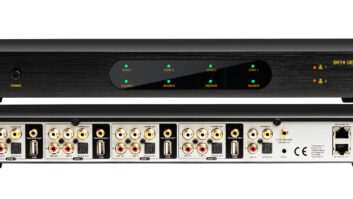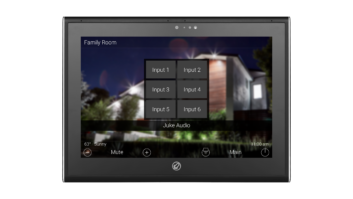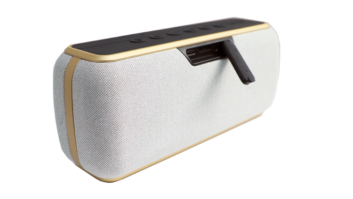Since 2005, Sonos has been delivering affordable and easy-to-install systems that distribute music wirelessly throughout a home. They also developed a control system that is both shockingly cheap and actually fun to use. But even though Sonos is often targeted to do-it-yourselfers, installers should consider making room for it in their bag of tricks.

Sonos has five system components, the CR200 color touchscreen, the BR100 ZoneBridge, and three ZonePlayers, the ZP90, the ZP120, and the new S5. A system can be as simple as one ZonePlayer or scaled up to 32 separate zones in any combination of ZonePlayers utilizing an unlimited number of controllers.
Sonos has five system components, the CR200 color touchscreen ($349), the BR100 ZoneBridge ($99), and three ZonePlayers, the ZP90 ($349), the ZP120 ($499), and the new S5 ($399). A system can be as simple as one ZonePlayer or scaled up to 32 separate zones in any combination of ZonePlayers utilizing an unlimited number of controllers.
Beyond the super cool CR200, with its so-sexy 3.5-inch, 640×480 color touchscreen, Sonos offers a free iPhone/iTouch app that virtually clones the CR200 experience and desktop control software for both PC and Mac.
The ZP90 is unpowered, with analog and digital (coaxial and optical) outputs for connection to an amplifier or powered speakers. The ZP120 includes a 55-watt/channel amplifier. The S5 is a complete solution, packaging digital amplification and five speaker drivers together.
Sonos assumes that modern listeners stream their music from the digital cloud or networked drives, and from that standpoint, there isn’t much that Sonos can’t handle. It plays MP3, iTunes Plus, WMA (including purchased Windows Media downloads), AAC, Ogg Vorbis, Audible, Apple Lossless, FLAC, WAV, and AIFF files. Beyond that, it also supports gazillions of Internet radio stations, Last.fm, Napster, Pandora, Rhapsody, and Sirius Internet Radio. Additionally, an analog source can be connected to any Player, and then listened to in any zone. It’s safe to say that with a Sonos system, your client will never run out of music.
Installation is incredibly simple, which is one of the reasons why it does so well in the DIY market. However, installers could utilize Sonos as a replacement for a rack full of gear in a typical home-run wiring install, either by replacing the amps with ZP120s, or by using the existing amps with ZP90s. The S5 can augment unwired rooms or be a perfect solution for portable listening in outdoor areas.
The actual install takes four simple steps:
1. Connect at least one ZonePlayer or the Zone Bridge via Cat cabling to a port on the network router. This hardwired device will then automatically create the SonosNet, secure encrypted, peer-to-peer, wireless 802.11n mesh network that other players will communicate on.
2. Power up and connect the other ZonePlayers. Each additional player can be wired Ethernet or WiFi. A nice feature is that all Players have two Ethernet ports, so they can be connected via hardwire while still providing a connection for another device like a NAS drive or a Profile 2.0 Blu-ray player.
3. Install the Sonos Desktop Controller software on your PC or Mac. Besides being a full system controller, it also scans up to 16 drives for compatible music files (libraries up to 65,000 songs are supported).
4. Add any controllers—either CR200 or iTouch/iPhones—to the system.
At this point, the system is ready to go.
A distributed audio system’s sound quality is unquestionably important, however usability and ergonomic design are often more critical. Sonos users will primarily use the CR200 or i-interface, both of which are so incredibly well-designed and intuitive that someone can pick them up and start enjoying the system almost instantly.
There are so many things to love about the controller— terrific graphics, quick response, metadata feedback for everything—that I will narrow my focus down to three really standout things. First is queuing up music and creating playlists. Most systems just won’t let you do this from a controller and your queue can contain music both from your library and Rhapsody and/or Napster (if you subscribe after the 30-day trial). Next is browsing music. I have 8,500 songs in my library, and Sonos let me search or power-scroll with a finger slide through an A-Z list or sweep though pages of your music. Finally is the ease of jumping from room to room and joining rooms to create multiple areas of synched audio.
Sonically, the ZP120 is a competent amplifier, on par with mid-priced, six-source/six-zone powered systems, including a subwoofer output for adding bass to a particular zone. The ZP90’s digital output was superior—more detailed, focused, and tight—than its analog out, no doubt because the DACs in my processor are far superior. The S5 sounded surprisingly good, playing much deeper than I expected. I placed it in my kitchen, and it definitely filled that space with rich sound, proving it would be a terrific addition to a desktop or master bathroom. As I pushed the volume to its northern limits, bass started distorting and cabinet vibrations became an issue, something that might be problematic if using a single S5 to supply your pool party’s audio. It also offers a headphone jack for private listening and is light enough to easily move from around the home.
And with the Sonos Twitter app, you can tweet your friends and followers, keeping them posted on your current music tastes.
I’ve reviewed nearly every audio distribution system, and the Sonos is one that never fails to impress me and which I continue to judge other systems against. With its quick install time, terrific user interface, free iControl app, and incorporation of so many music sources, installers should embrace it as a solution for customers looking for a terrific audio-only system.







